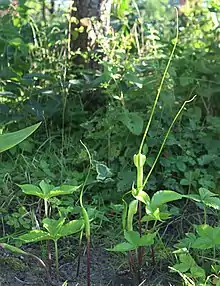| Pinellia | |
|---|---|
 | |
| Pinellia ternata | |
| Scientific classification | |
| Kingdom: | Plantae |
| Clade: | Tracheophytes |
| Clade: | Angiosperms |
| Clade: | Monocots |
| Order: | Alismatales |
| Family: | Araceae |
| Subfamily: | Aroideae |
| Tribe: | Arisaemateae |
| Genus: | Pinellia Ten. |
| Type species | |
| Pinellia tuberifera | |
 | |
| Range of the genus Pinellia | |
| Synonyms[1] | |
| |
Pinellia is a genus of plants in the family Araceae native to East Asia (China, Korea, Japan).[1][2][3][4] Its species are commonly called green dragons due to the color and shape of the inflorescence, which possesses a green, hooded spathe from which protrudes a long, tongue-like extension of the spadix. The leaves vary greatly in shape among different species, from simple and cordate to compound with three to many leaflets. Pinellia reproduces rapidly from seed and many species also produce bulbils on the leaves. Both characteristics have allowed some species to become weedy in temperate areas outside their native range, notably Pinellia ternata in eastern North America.[5][6]
Species
| Image | Name | Distribution |
|---|---|---|
 | Pinellia cordata N.E.Br. | Anhui, Fujian, Guangdong, Guangxi, Guizhou, Hubei, Hunan, Jiangxi, Zhejiang |
| Pinellia fujianensis H.Li & G.H.Zhu | Fujian | |
| Pinellia integrifolia N.E.Br. | Sichuan, Chongqing, Hubei | |
 | Pinellia pedatisecta Schott | Anhui, Fujian, Guangxi, Guizhou, Hebei, Henan, Hubei, Hunan, Jiangsu, Shaanxi, Shandong, Shanxi, Sichuan, Yunnan, Zhejiang |
| Pinellia peltata C.Pei | Fujian, Zhejiang | |
| Pinellia polyphylla S.L.Hu | Sichuan | |
 | Pinellia ternata (Thunb.) Makino | Japan, Korea, Ryukyu Islands, most of eastern + central China; naturalized in Germany, Austria, California, Ontario, northeastern United States |
 | Pinellia tripartita (Blume) Schott | Japan, Ryukyu Islands, Hong Kong |
| Pinellia yaoluopingensis X.H.Guo & X.L.Liu | Anhui, Jiangsu | |
Use in Traditional Chinese Medicine
The processed root, known as Zhi ban xia or Ban xia, is one of the most important herbs in Chinese Medicine to transform phlegm and stop coughing. The herb is warm and drying and should be used only in people who are not hot or dry (known as yin deficient.) It is used in small 3-6 gram dosages in herbal formulas to warmly dry the lungs, to stop nausea and vomiting, and to address goiters or scrofula. Slices of the dried root are also used as a base for moxibustion. Because the raw root is toxic, it is soaked in water to remove oxalates and other irritants, or processed with ginger. Unprocessed root is only used externally in Chinese Medicine.[7]
When listed as an ingredient in a supplement for weight loss or energy, Pinellia has been charged with indicating the presence of ephedra alkaloids,[8] which would be a violation of labeling laws.
References
- 1 2 Kew World Checklist of Selected Plant Families
- ↑ Flora of China Vol. 23 Page 39, 半夏属 ban xia shu, Pinellia Tenore, Atti Reale Accad. Sci. Sez. Soc. Reale Borbon. 4: 69. 1839.
- ↑ Govaerts, R. & Frodin, D.G. (2002). World Checklist and Bibliography of Araceae (and Acoraceae): 1-560. The Board of Trustees of the Royal Botanic Gardens, Kew.
- ↑ Zhu, G., Li, H. & Li, R. (2007). A synopsis and a new species of the E. Asian genus Pinellia (Araceae). Willdenowia 37: 503-522.
- ↑ http://www.pacificbulbsociety.org/pbswiki/index.php/Pinellia Pacific Bulb Society Wiki
- ↑ Biota of North America Program, 2013 county distribution maps
- ↑ Dan Bensky, Steven Clavey, Erich Stoger, and Andrew Gamble. Chinese Herbal Medicine: Materia Medica, Third Edition,2004: 413-418
- ↑ First ban of a supplement tests 1994 law
External links
- Pinellia tripartita Images